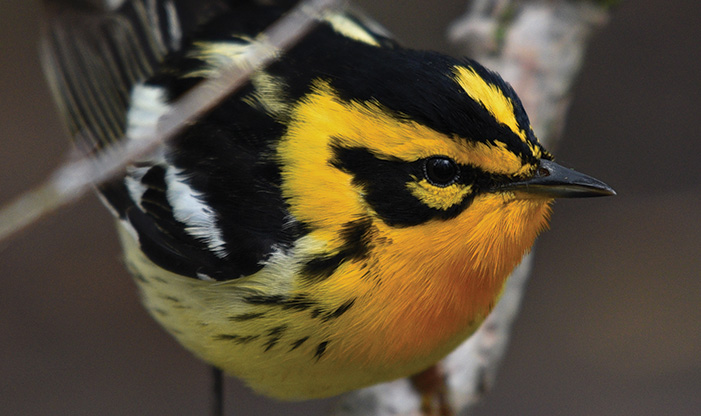Spring Migration is the most exciting time of year for bird watchers. The burst of color and song on a May morning is one of my favorite experiences in the natural world. Fiery oranges, golden to olive yellows, vibrant blues, and even striking patterns of simple black and white draw our eyes and binoculars.
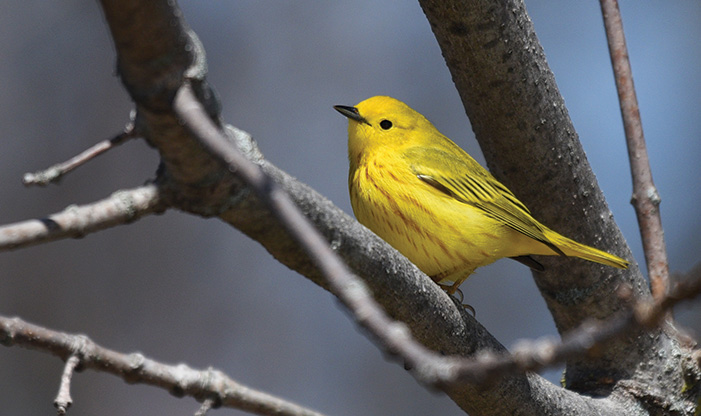
Yellow Warbler Setophaga petechia
In Milwaukee, we have hundreds of bird species that will migrate through in spring. Among the varied group of migrants that pass through, there is one group that is the epitome of excitement and joy surrounding spring migration—warblers. Warblers, or wood-warblers, are a group of songbirds that account for most of the brightness that graces Schlitz Audubon’s canopy from April through June.
What is a Warbler?
What makes a warbler a warbler, and why are they so special? Warblers are a group of birds in the family Parulidae. There are 53 species of warbler in North America. Thirty-five species have been observed over the years at Schlitz Audubon. Although each species within the family is unique with separate songs, colors, and migration patterns, they share some basic characteristics. For the most part, they are small to medium-sized songbirds. They primarily eat insects, though certain species eat berries and nectar in winter. Because of their insectivorous diet, one common characteristic of these birds is the shape of their bill—thin and pointed.
There are different foraging techniques within the Parulidae family. Overall these birds are some of the most active, flitting sporadically from branch to branch. Some birds within the family, like the Blackburnian Warbler, will glean insects and spiders on branches high in a tree. Another species, the Ovenbird, acts more like a thrush.
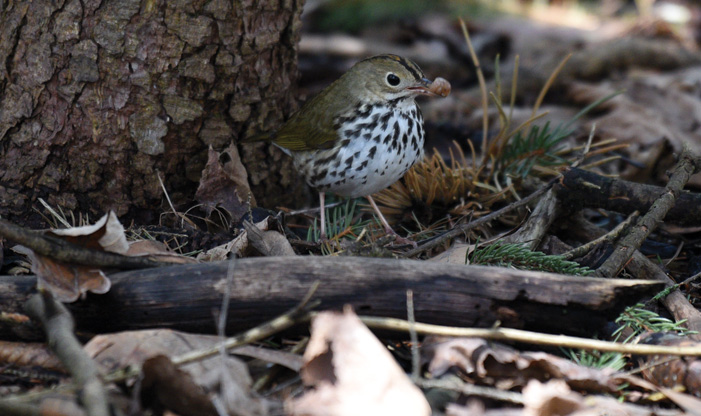
Ovenbird Seiurus aurocapilla foraging larvae on the forest floor at Schlitz Audubon.
It forages on the forest floor for insects and larvae hidden in fallen leaves. And the Black-and-White Warbler acts more like a nuthatch, creeping on tree bark, picking out insects.
What Drives Migration?
Warblers are Neotropical migrants which means they spend their winters as far south as South America, Central America, and the Caribbean. Traveling as far north as Canada to breed, they make an incredible journey. An internal clock determined by photoperiods of unbroken darkness urges them north towards an insect feast that fuels their primal drive to reproduce. Warblers migrate at night, and although scientists do not know exactly how their migration route is determined, there are a few hypotheses.
Research on the Magnolia Warbler verified that within its genes is a map of the constellations of the Northern Hemisphere, one of the tools they use for navigation during migration. Some warblers orient themselves by the position of the sun, and some rely on magnetic fields. In general, each species has an innate compass that drives them north, but this may be something we never fully understand.
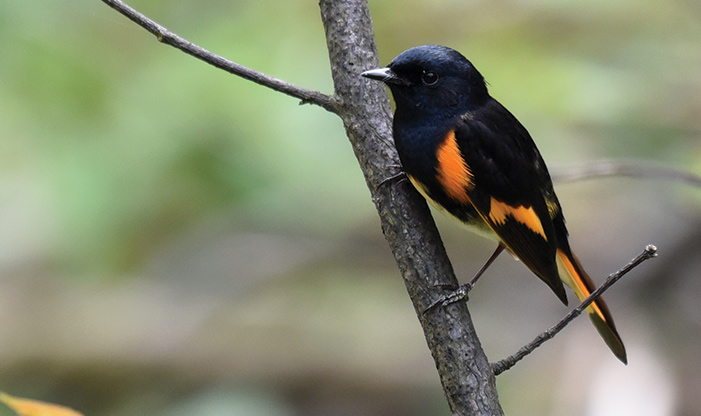
American Redstart, Setophaga ruticilla
There are a few species—American Redstart, Yellow Warbler, and Common Yellowthroat—that can nest in Milwaukee County, but most travel farther north. And then they make the journey back to their wintering grounds in fall. The Blackpoll Warbler’s fall migration route has been studied, and it was found that they have one of the longest non-stop flights over open ocean of any songbird. They fly directly over the Atlantic Ocean for up to 1,800 miles!
Look for the Spectacular Colors
Besides their specific bill shape, and migration, what makes warblers so special? Their color and song sets them apart from other North American migrants, especially males in spectacular breeding plumage. A male Blackburnian has the fieriest orange throat you can imagine. Blackburnians generally make their appearance back to Wisconsin the first or second week in May.
I was lucky to find one on April 25 last spring, a week earlier than normal. It ended up being the first record for the state for 2016. A gleam of orange caught my eye as the sun was setting, illuminating the bird in a way that made me pause and reflect. A Northern Parula has a beautiful blue head, yellow chest, and a rusty patch that bleeds from the yellow. The Chestnut-sided Warbler has a chartreuse head, and chestnut patches on its sides. The Canada Warbler, entirely yellow on its breast and underside, is adorned with a dark “necklace”, and contrasting blue on its back. During spring, an entire rainbow exists within the canopy!
The Sounds of a Warbler’s Song
Warblers sing some of the most beautiful but difficult to distinguish songs. From the family name, you could guess that their songs “warble.” The Yellow Warbler has a perfect song to exemplify this. They sing “Sweet Sweet Sweet, Little More Sweet,” in a high-pitched, fast-paced song. Even the Black-throated Green Warbler, which has a buzzier property, is still melodic saying “zee-zee-zee-zoo-zee” with a sweet sound in the middle. It can be difficult to describe the melodies present in spring through words, so I’d invite you to take a walk on a May morning, and let the warblers’ songs fill your ears.
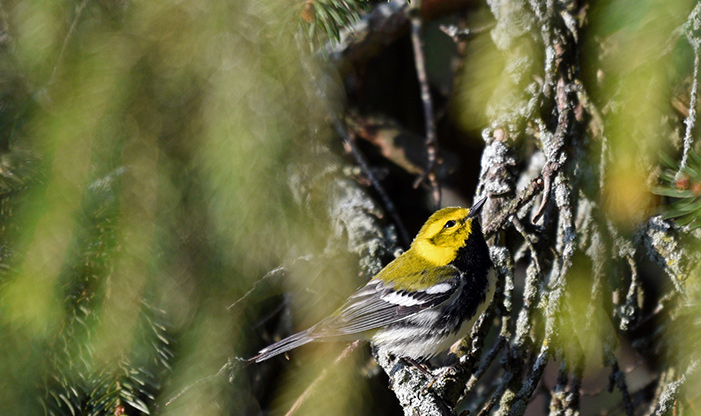
Black-throated Green Setophaga virens
Warbler migration starts for Schlitz Audubon and Southeastern Wisconsin in early April. From there, we will have waves of different migrants until it tapers off in late May and early June. The most common that you could expect to see are: Yellow-rumped Warbler, Black-and-White Warbler, Black-throated Green, Ovenbird, Yellow Warbler, Northern Parula, Nashville Warbler, Northern Waterthrush, Cape May Warbler, American Redstart, and Blackburnian Warbler. Some of the rarities we have had in the past include the Prairie Warbler, Connecticut Warbler, Worm-eating Warbler, and Prothonotary Warbler.
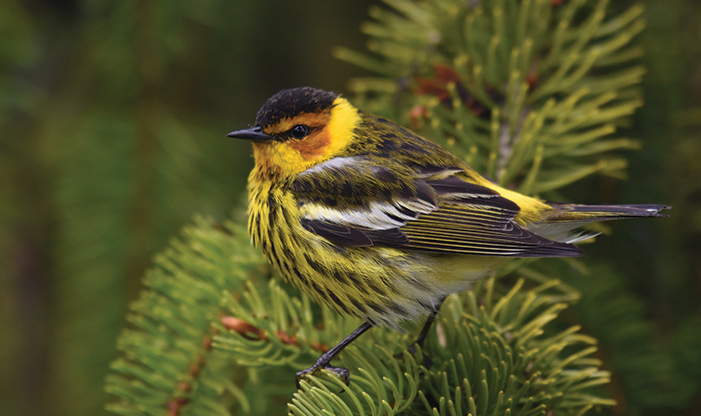
Cape May Warbler Setophaga tigrina
Many warblers only spend a few weeks a year in Milwaukee. For the most part, places like Schlitz Audubon are just a stop on their migration route to their breeding grounds, making it a rare treat to see them. We provide crucial stopover habitat for these birds to refuel on their migration route, continuing nature’s cycle each year.
